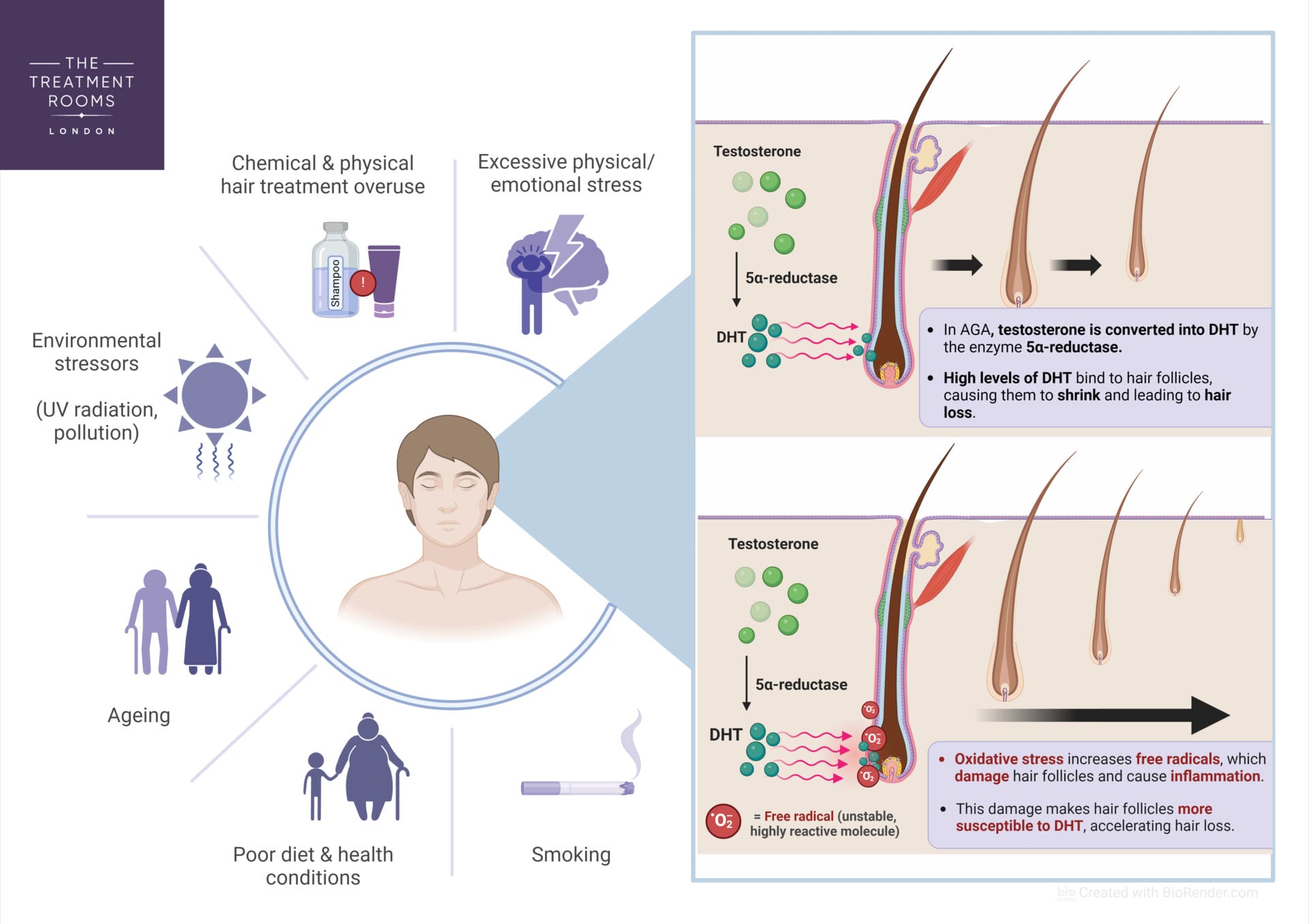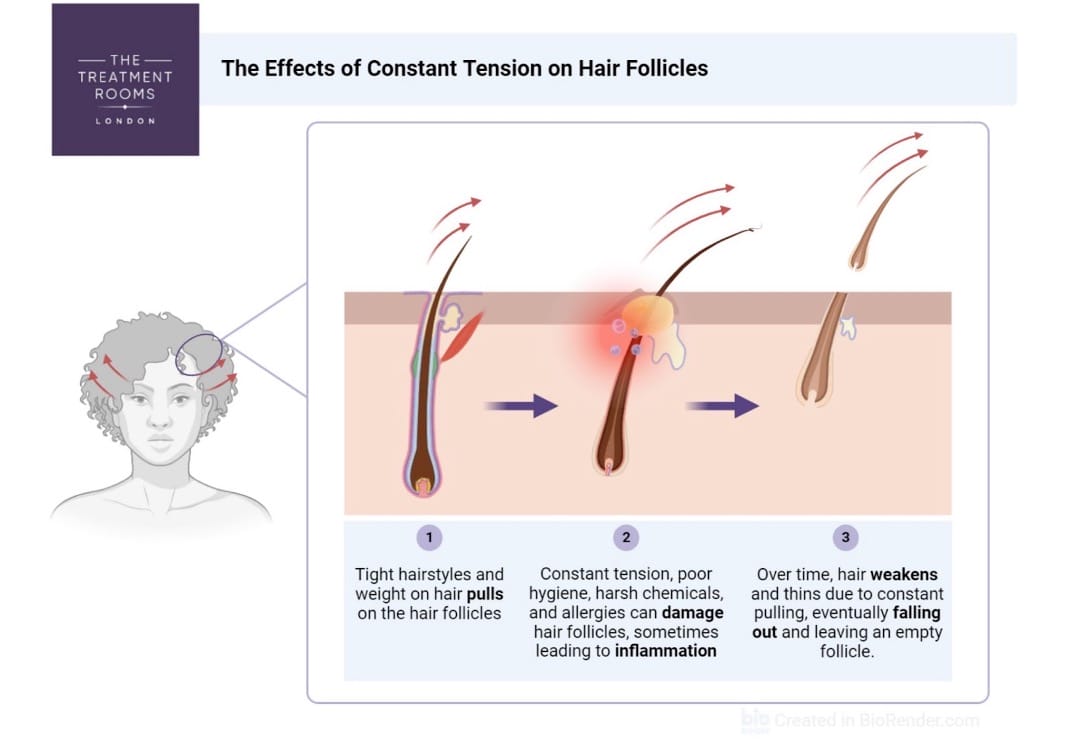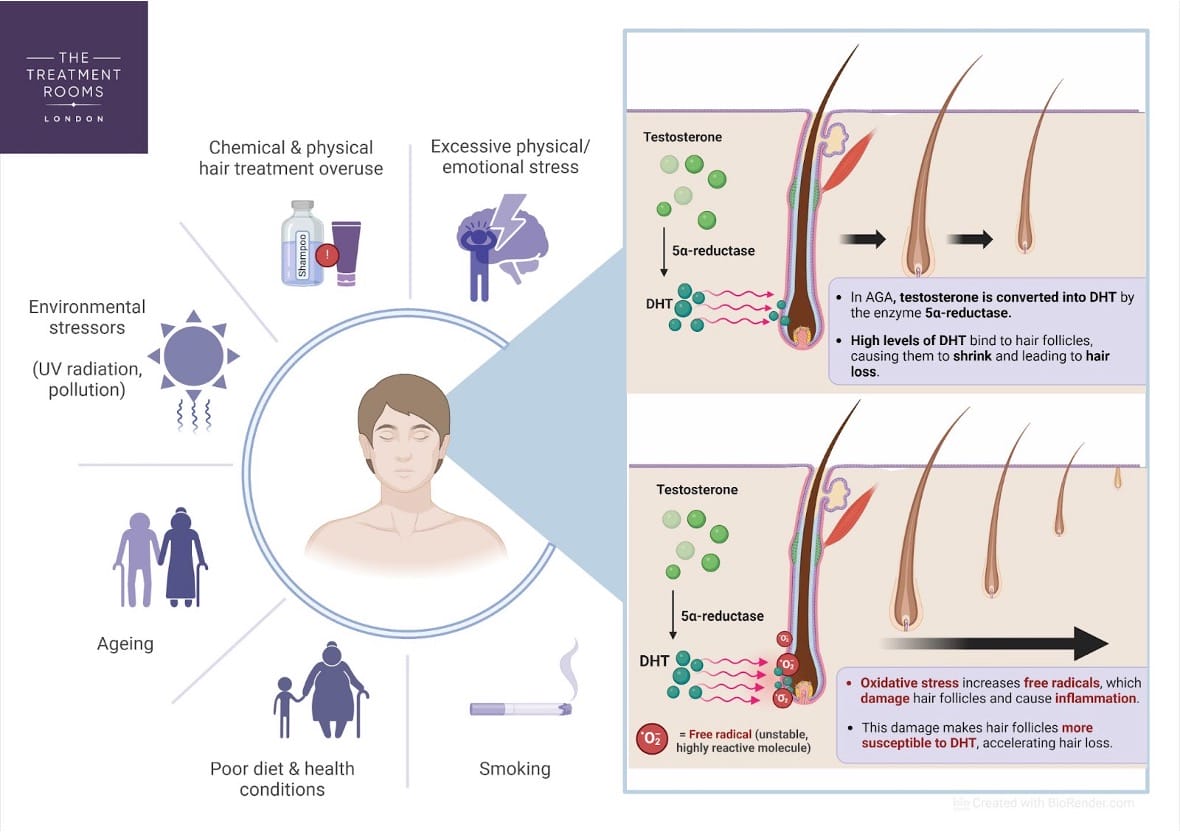Quick Summary
What is a Receding Hairline? In women, a receding hairline is often more subtle than in men, manifesting as widespread thinning across the head or a more even recession at the forehead.
Common Causes: Besides genetic factors, receding hairlines in women can be influenced by hormonal fluctuations (like those during menopause), certain hairstyles (like tight ponytails that cause traction alopecia), and medical conditions such as frontal fibrosing alopecia or trichotillomania.
Diagnosis and Treatment: Early diagnosis by a specialist is crucial to managing and potentially reversing the condition. Treatments vary based on the underlying cause and may include topical solutions like Minoxidil, hormone therapy, or even surgical options such as hair transplants.
Key Takeaway: If you’re experiencing a receding hairline, it’s important to consult with a healthcare provider to determine the cause and appropriate treatment. Managing hair health involves both medical intervention and lifestyle adjustments to ensure the best outcomes for hair restoration and maintenance.
Experiencing a receding hairline can be a distressing change for many women, impacting not only their appearance but also their self-esteem. This blog explores the nuances of receding hairlines in women, shedding light on the causes, symptoms, and treatments available.
What is a Receding Hairline in Women?
A receding hairline is when you notice gradual hair loss at the forehead and temples, resulting in the hairline moving backward. In women, the way the hairline recedes is different to men. Women with female pattern hair loss (FPHL, also known as female androgenetic alopecia) tend to retain their frontal hairline, but experience widespread hair thinning across the top of the head.1
In postmenopausal women, a receding hairline can typically occur more evenly across the forehead2, rather than forming the distinctive “M”- shaped hairline seen in men. This is different to a V-shaped, widow’s peak hairline that some women can develop as a natural part of ageing. You can find out about a widow’s peak in women by reading our dedicated article on the topic here. An example of this hairline can be seen in the image below.

While a receding hairline is more commonly one of the first signs of male androgenetic alopecia, women also experience a receding hairline due to various factors such as genetics, hormonal imbalances, ageing, and certain medical conditions.1,2
A receding hairline is a sign of significant hair loss in women, and the underlying condition must be diagnosed by a specialist. It can occur at different points in a women’s life and it is difficult to know at what age hair loss will stop; for more information, please refer to the topic what age does hair loss stop in women? At The Treatment Rooms, we advise seeking advice in a timely manner to prevent further hair loss and worsening hair and overall health.
Apart from being a late sign of Female Pattern Hair Loss3, a receding hairline may be an initial sign of other types of hair loss. These include the following1,2,4:
- Frontal fibrosing alopecia (FFA) – Primarily affecting post-menopausal women, this type of scarring alopecia presents with a symmetrically receding hairline, forming a band of hair loss along the front and sides of the scalp.
- Traction alopecia – Prolonged tension on the hair, often due to tight hairstyles like high ponytails, braids and extensions, may cause the hairline to recede due to the constant pulling of hairs in these areas. This occurs typically in the forehead and temple regions.
- Trichotillomania – Depending on the area where compulsive hair pulling occurs most frequently, damage done by this motion can cause the hairline to recede.
Other eventual causes of a receding hairline in women that initially present as diffuse or patchy hair loss include:
- Other Cicatricial (Scarring) Alopecia – A group of rare disorders that destroy hair follicles and replace them with scar tissue, leading to permanent hair loss. Frontal Fibrosing Alopecia discussed above falls into this category. A receding hairline can occur if the frontal scalp is affected, and is often accompanied by inflammation, redness and eventual scarring.
- Telogen Effluvium – A sudden, temporary loss of hair due to situational stress (illness, hormonal changes, physical or mental stress), causing a drive in free radical production causing a large number of hair follicles to enter the telogen (resting) phase of the hair growth cycle. This can result in diffuse thinning across the scalp. In severe or chronic cases, this can lead to hairline recession. The relationship of stress and hair loss is summarised in the diagram below.

Female Hair Loss Overview
Female hair loss is a complex topic, and it’s hard to give a definitive answer for the cause of a receding hairline. However, by exploring the different types of hair loss women face and acknowledging the complex nature of it, we may better understand what can cause a hairline to recede.
To simplify, we can categorise the possible causes as described below:
- Genetic predisposition:
Female Pattern Hair Loss can be passed down through genes, and although a receding hairline may not be its first sign, it is a possible contributor.5
- Hormonal changes:
Women are especially prone to hormonal fluctuations throughout their lives. The changes experienced during puberty, pregnancy, after childbirth, and menopause can all play a role in hair loss.6
- Underlying medical conditions:
Hair loss can indicate underlying health conditions, particularly genetic, hormonal or autoimmune disorders. Conditions such as Polycystic Ovary Syndrome (PCOS), alopecia areata, lupus, anaemia, and thyroid issues6,7 are more prevalent in women than in men, and can contribute to hair loss.
- Medications:
Side effects from medications, including blood thinners, beta blockers (for heart conditions), certain antidepressants, and chemotherapy, may cause hair loss.8
- Nutritional deficiencies:
Lack of essential nutrients, especially iron (due to anaemia) and vitamins D and B (including B5, B6, and B7 or biotin), can affect hair health. Maintaining a well-balanced diet rich in essential nutrients is crucial for promoting natural healthy hair growth.
- Stress:
Stress can push hair into a resting phase, leading to shedding. Managing stress through healthy lifestyle habits can help prevent hair loss caused by excessive hair or scalp picking, smoking, lack of protection from excessive UV rays, and stressors related to work and personal life.
- Hair styling practices
Hair styling can be another common reason for a receding hairline, especially styles that pull the hair back tightly, leading to traction alopecia. Frequent chemical treatments such as dyes, bleaches, or perms can also damage the hair shaft and follicles.

Signs and symptoms of female pattern hair loss and a receding hairline in women
The most common signs and symptoms of significant hair loss in women are:
- Thinning hair – noticeable reduction in hair volume, particularly at the temples (hairline) and crown.
- Widening part – the part in your hair may become wider and more visible, indicating hair thinning
- Excessive shedding – you may find more hair fall on your pillow, brush and/or in the shower
- Visible scalp – you may see your scalp more through the hair.
- Slow hair growth – hair might take longer to grow back after falling out because of the disruption to the normal hair growth cycle attributed to the causes mentioned above.
- Hair breakage – hair may become more fragile, leading it to break easily. This, in turn, can affect the overall hair density, even around the hairline.
Research Highlights on FPHL and Receding Hairline in Women
Studies have been conducted to better understand the impact of hair loss in women, particularly focusing on receding hairlines. Here are highlights from two notable studies:
Study 1: Maryborough, Australia9
In this study, the prevalence of both male and female pattern hair loss was investigated through questionnaires. Focusing on receding hairlines in women, the key findings included the following:
- The study assessed mild and marked bitemporal recession. It found that moderate recession affected 55.2% of the 474 women surveyed, while marked recession affected 9.2%.
- While marked bitemporal recession is less common in women than in men, moderate recession is quite prevalent, underscoring the importance of recognising and addressing a receding hairline in women.
- The study found a significant association between hair thickness and the degree of recession in both men and women. Restoring or enhancing hair thickness could be beneficial for women experiencing a receding hairline.
- About 55% of women potentially affected by FPHL rated their hair pattern as stage 3 to stage 5 on a grading scale, but did not report hair loss as a significant concern. This suggests that women with FPHL may not initially perceive hair loss as cosmetically significant enough to seek medical intervention.
Study 2: Enugu, Nigeria10
This study surveyed women aged 25-60 about their experiences with receding hairlines. Here are the key findings:
- A significant number of women, particularly those aged 35-44, experience a receding hairline.
- Women associated a receding hairline with looking older, reduced attractiveness, and emotional distress.
- Most women only identified hair plaiting as a cause of hairline recession, while other causes like frequent dyeing, pregnancy, genetic factors, and underlying health conditions were not widely recognised.
- Participants were generally unaware of preventive measures, such as careful handling of wet hair, and the importance of a healthy lifestyle. They were also mostly unaware of the need for a proper treatment plan to address hairline recession.
- Despite the lack of knowledge, women expressed a strong willingness to address a receding hairline, highlighting its importance to them.
Both studies emphasise the need for greater awareness in recognising hair loss in women and understanding when it is significant enough to seek medical help. They highlight the importance of educating women on proper hair care to prevent significant hair loss, recognising symptoms that may indicate underlying health conditions, and seeking timely and appropriate treatment plans. At The Treatment Rooms, we highly encourage women to take proactive steps in managing their hair health and seeking medical advice when necessary, rather than waiting for obvious signs of hairline recession.
How to Stop a Receding Hairline
It is important to first find the main cause of your hair loss, and the best way to do this is to have a chat with your GP, who may also refer you to a dermatologist or hair specialists like our team. After identifying the underlying issue, you may be suggested treatment methods that include5,11:
- Making Lifestyle Adjustments
- Diet: Ensure a well-balanced meal, including hair-nourishing nutrients like protein, omega 3, iron, and vitamins. You may find our blog on a healthy diet for hair health helpful.
- Stress management: As mentioned, stress is a common factor in hair loss. Taking time out of your day to perform stress relieving activities like medication, yoga, or therapy if needed, can help manage stress-related hair loss.
- Improving Hair Care Practices
- Gentle Styling: Spending some time carefully going through your hair care routine, and stopping any practices that might be damaging your hair and scalp would be helpful. This includes avoiding tight hairstyles, harsh chemical treatments, and excessive heat styling.
- Product Choice: Everyone’s hair and skin is different, so it’s also important to choose the correct type of products that work best for your hair and scalp. Milder products that are more gentle on your hair and scalp would be beneficial.
- Taking Medical treatments:
- Topical Minoxidil 2% or 5%: A well-known and scientifically proven medication that can stimulate hair growth.
- Hormone therapy: For menopausal women, who are most at risk of hair loss, hormone replacement therapy may help compensate for reduced oestrogen and progesterone levels, both of which play protective roles against hair loss.
- Anti-androgens: These are medications (e.g. spironolactone) that can reduce androgen levels. Androgens are male hormones (e.g testosterone) present in both men and women, and cause hair loss through androgenetic alopecia. You can read a dedicated article on this topic: Can women take DHT blockers?

4. Considering Advanced treatments:
- Platelet-Rich Plasma (PRP) Therapy: This involves injecting your own platelets (cell fragments found in your blood that contain growth factors) into the scalp to promote hair growth in areas experiencing hair loss.
- Low Level Laser Therapy (LLLT): Low-intensity lasers or LEDs are used to stimulate hair follicles, improve blood flow, and promote hair growth in needed areas.
- Hair Transplant Surgery: Surgeries like Follicular Unit Extraction (FUE) or Follicular Unit Transplantation (FUT) can be a permanent solution for hair loss, provided that any underlying causes are identified and well-controlled.
Sometimes, individuals naturally have a hairline that sits slightly higher on the forehead. This can be completely normal and not necessarily indicative of any underlying medical condition, but rather a genetic trait also called a congenitally high hairline. If you are considering cosmetically adjusting your hairline, our hair transplant specialists are highly experienced and knowledgeable – they can provide personalised advice and discuss the best options for bringing your hairline forward. You can review our case studies or contact us directly to learn more about the procedures available.
Conclusion
To sum up, a receding hairline in women can result from various factors. Understanding the signs and seeking appropriate treatment can help manage and potentially reverse hair loss.
Our first advice would be to assess whether your hair styling or lifestyle habits might be contributing to your receding hairline. Opt for gentle hair care routines and relaxed hairstyles to minimise damage. However, if you suspect that your hair loss is more significant and not solely due to styling practices, we strongly recommend consulting with a healthcare provider. They can diagnose any underlying conditions and develop the best treatment plan tailored to your needs.
Taking proactive steps now can make a significant difference in maintaining and restoring your hair health. If you have any questions or need further assistance, feel free to reach out to our team of specialists and we would be happy to help.
References
- Phillips TG, Slomiany WP, Allison R. Hair loss: Common causes and treatment. American Family Physician 2017. https://www.aafp.org/pubs/afp/issues/2017/0915/p371.html (accessed May 11, 2024).
- Zaouak, A., Ghorbel, H. H., Badri, T., Koubaa, W., & Fenniche, S. (2015). Frontotemporal hairline recession in a postmenopausal woman. Dermatology practical & conceptual, 5(2), 129–131. https://doi.org/10.5826/dpc.0502a26
- Dinh, Q. Q., & Sinclair, R. (2007). Female pattern hair loss: current treatment concepts. Clinical interventions in aging, 2(2), 189–199. Available from: https://www.ncbi.nlm.nih.gov/pmc/articles/PMC4462917
- Singal, A., Sonthalia, S., & Verma, P. (2013). Female pattern hair loss. Indian journal of dermatology, venereology and leprology, 79(5), 626–640. https://doi.org/10.4103/0378-6323.116732
- Fabbrocini, G., Cantelli, M., Masarà, A., Annunziata, M. C., Marasca, C., & Cacciapuoti, S. (2018). Female pattern hair loss: A clinical, pathophysiologic, and therapeutic review. International journal of women’s dermatology, 4(4), 203–211. https://doi.org/10.1016/j.ijwd.2018.05.001
- Grymowicz, M., Rudnicka, E., Podfigurna, A., Napierala, P., Smolarczyk, R., Smolarczyk, K., & Meczekalski, B. (2020). Hormonal Effects on Hair Follicles. International journal of molecular sciences, 21(15), 5342. https://doi.org/10.3390/ijms21155342
- Redler, S., Messenger, A. G., & Betz, R. C. (2017). Genetics and other factors in the aetiology of female pattern hair loss. Experimental dermatology, 26(6), 510–517. https://doi.org/10.1111/exd.13373
- Dyall-Smith D. Alopecia from drugs. DermNet 2009. https://dermnetnz.org/topics/alopecia-from-drugs (accessed May 11, 2024).
- Gan, D. C., & Sinclair, R. D. (2005). Prevalence of male and female pattern hair loss in Maryborough. The Journal of Investigative Dermatology. Symposium proceedings, 10(3), 184–189. https://doi.org/10.1111/j.1087-0024.2005.10102.x
- Eneh, Onyenekenwa & Chima, Faith. (2013). Receding Hairlines: Prevalence, Importance, Causes, Prevention And Remediations Among Nigerian City Women. Journal of Applied Sciences and Development, 4, 17-53. Available from: https://www.researchgate.net/publication/279511811
- NHS. Women and hair loss: coping tips. NHS Choices 2024. https://www.nhs.uk/conditions/hair-loss/coping-tips-for-women/ (accessed May 11, 2024).
- Diagrams illustrated using BioRender.com
Share:
Authored by
Reviewed by
Book a Consultation
Related Blogs
Stephen Miller’ Hair Spray Gone Bad: Our Expert Coments and Insights
April 24, 2025
When Stephen Miller appeared on “Face the Nation”, his hairspray cover-up would later set social media on…
Ariana Grande Hair Loss: Prevention, Styling Secrets, and Hypothetical Transplant Solutions
April 10, 2025
Ariana Grande, the global pop sensation renowned for her signature high ponytail and bold hairstyles, has openly…
Daniel Craig Hair Transplant: Before, After and His Hairline
April 10, 2025
Daniel Craig, the world-famous English actor who gained international fame as the fast-paced, debonair James Bond, has…
Rob Brydon Hair Transplant: Before, After, and His New Hairline
April 8, 2025
Rob Brydon, the beloved Welsh comedian and Gavin & Stacey star, has traded his receding hairline for…
Gordon Ramsay Hair Transplant: Before, After, and His New Hairline
April 3, 2025
Gordon Ramsay, the fiery Michelin-starred chef, restaurateur, and TV personality, has swapped his receding temples for a…
Has Perez Hilton had a hair transplant? All You Need to Know
April 2, 2025
Perez Hilton is a familiar face in the media. He is known for his work as a…
Ronnie Vint – Love Island Hair Transplant: Before, After, And His Hairline
March 31, 2025
Ronnie Vint, a former footballer and current TV personality, appeared on the 2024 season of “Love Island”…
Prince Harry Hair Loss: Speculations, Treatments, and Possible Transplant Options
March 28, 2025
Prince Harry, the Duke of Sussex and beloved royal-turned-global humanitarian, has sparked global curiosity over his ever-evolving…
Elton John and His Hair Transplant Journey
March 27, 2025
Sir Elton John has had one of the greatest careers in music. Since his rise to fame…











